Main Article: Mercedes-Benz O405G
The Mercedes-Benz O405G (Hispano Carrocera Habit) is the third generation of Mercedes-Benz O405G articulated buses acquired by Trans-Island Bus Services (TIBS), the predecessor of SMRT Buses.
Featuring an all-new exterior design by renowned Italian design company Pininfarina, the O405G Hispano Habit buses bear similar technical specifications and interior configurations as compared to the earlier Hispano Mark I & II buses and later Volgren-bodied units.
Built between 1999-2002, 208 buses of this type were built and delivered in two batches. They entered service between June 2000 to March 2004 (however, most units were registered by December 2001).
Introduction
In 2000, Trans-Island Bus Services (TIBS) introduced a third series of the Mercedes-Benz O405G buses, now fitted with the ‘Habit’ city bus bodywork by Spanish coachbuilder Hispano Carrocera.
Hispano Carrocera had engaged renowned Italian design company Pininfarina for the bodywork design, a company well-known for its long-term partnerships with leading car manufacturers. TIBS was the ‘launch customer’ for the Hispano Habit bodywork, purchasing the first batch of buses with this new bodywork.
These 208 buses were registered between 10 June 2000 and 4 March 2004 as TIB1019Z – TIB1177A (excluding TIB1024H), and TIB1198P – TIB1247G. However, most units were registered by December 2001.
| Basic Technical Specifications | ||
| Batch 1: TIB1019Z – TIB1147L (except TIB1024H) | Batch 2: TIB1148J – TIB1177A, TIB1198P – TIB1247G | |
| Engine | Mercedes-Benz OM 447 hLA engine Inline 6-cylinder turbocharged, 11967 cc Power/Torque rating of 299 hp (220 kW) @ 2200 rpm / 1250 Nm @ 1000 – 1300 rpm Batch 1 buses rated at Euro I, Batch 2 buses rated at Euro II |
|
| Transmission | ZF Ecomat 4HP 590 gearbox, four-speed automatic (132 units) Voith DIWA 863.3 gearbox, three-speed automatic (76 units) |
|
| Bodywork | Hispano Carrocera Habit Bodywork Chassis produced in Germany. Bodywork supplied by Hispano Carrocera of Spain. |
|
| EDS | Mobitec MobiLED Electronic Display Signage (EDS) Orange LED Matrix design Original model: LAWO ALUMA and Transit Media TwinVision LeDot (Green flip-dot) Gorba imotion (TIB1132D, TIB1133B, TIB1242U), Hanover (TIB1034D), LAWO BENEFIT (TIB1105H) – All Orange LED models |
|
| Doors | Bode-Masats doors Double-leaf doors for entrance, double plug doors for both exits |
|
| Capacity | Licensed capacity of 149 passengers: 59 seating and 90 standing passengers |
|
Additional Specifications:
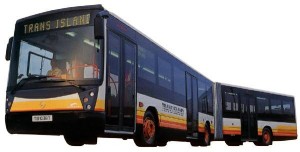
Hispano Carrocera had engaged Pininfarina for the bodywork design. TIBS was the ‘launch customer’ for the Hispano Habit bodywork, purchasing the first batch of buses with this new bodywork. The design of the Hispano Habit was iconic, and soon became TIBS’s flagship bendy bus, as well as being the most common on the roads. It is easily recognisable by its dark front design and styling elements, such as the black border around its single-piece windscreen and headlights set against a black background.
These buses were fitted with a standard Mercedes-Benz OM 447 hLA engine paired with mix of Voith DIWA 863.3 (3-speed) and ZF Ecomat 4HP 590 (4-speed) automatic transmissions, in contrast to the earlier two Hispano MkI and MkII buses delivered only with the ZF transmission. Bodied by Spanish company Hispano Carrocera, underfloor air-conditioning was supplied by Hispacold. A set of dual-leaf inward-gliding entrance doors and two sets of dual-leaf plug doors for the exits were supplied by Bode-Masats. All doors are pneumatically operated.
At delivery, these buses were fitted with a set of either LAWO ALUMA or Transit Media TwinVision LeDot Electronic Display Signage (EDS). These Green Flip-Dot type EDS units had LEDs behind each individual flip-dot for improved visibility, as compared to the older Flip-Dot units on the Hispano MkI which used fluorescent lamps for illumination.
The Mercedes-Benz O405G (Hispano Habit) boasted wider legroom with cantilever seats, adjustable air-conditioning louvres to allow passengers to adjust the airflow to their liking, and more vertical stanchion poles for passengers to move around easily and safely. Advanced safety features such as accelerator interlock ensure that all doors are fully closed before the bus can move off. The driver’s compartment was also touted to be ergonomic and designed with improved visibility angles for the comfort and safety of the driver.
Batch 1 and 2
Batch 1:
An initial batch of 128 buses was procured and registered as TIB1019Z – TIB1147L (except TIB1024H), with TIB1024H already taken by the Volgren O405G demonstrator. They were registered from 10 June 2000 to 30 December 2000. 37 units were fitted with the Voith DIWA 863.3 transmission while the remaining 121 buses had the ZF Ecomat 4HP 590 transmission.
On Sunday, 18 June 2000, Trans-Island Bus Services (TIBS) organised joyrides at five bus interchanges (Bukit Panjang, Bukit Batok, Choa Chu Kang, Yishun, Woodlands) to let passengers have a feel of its newest bus, from 11:00am to 3.0pm at half-hour intervals. That same day, TIBS took over Services 77, 189, 361, 365 and 367 from Singapore Bus Services (SBS).
An interesting note is that TIB1019Z – TIB1023K were registered very late, on 30 Dec 2000 together with the last few buses of the Batch 1 Hispano Habits (Registration of TIB1025E onwards started in June 2000). This has roots going all the way back to the Dennis Lance. Originally, TIB1002X – TIB1021R was reserved for the 20 UK Lances, TIB1022M & TIB1023K was reserved for the Volgren Lance, and TIB1024H was reserved for the Volgren O405G demonstrator. However, due to the expansion of SMRT’s charter division Bus-Plus which required 12-metre buses, five UK Lances were transferred and registered under the PA-plate. As a result, only 15 UK Lances were registered under the TIB sequence (TIB1002X – TIB1016G) , pushing forward the Volgren Lance (TIB1017D & TIB1018B), and leaving five unused numbers between TIB1019Z to TIB1023K as TIB1024H was already registered. In keeping with long-time practices, TIBS was keen to fill up the missing numbers rather than leaving them empty, and as such, the last few Batch 1 Hispano Habits were registered to fill up those unused numbers.
Batch 2:
The second batch of 80 buses was similar in all technical aspects to the Batch 1 buses, except that their engines were tuned to meet the Euro II emissions standards. Half of them were fitted with the ZF Ecomat 4HP 590 transmission while the remaining half received the Voith DIWA 863.3 transmission.
One curious feature of this batch is the extended period of time needed for registration. While the first 50 units (TIB1148J – TIB1177A TIB1198P – TIB1217T) were delivered in eight months (29 May 2001 – 21 Dec 2001), the last 30 units (TIB1218R – TIB1247G) took around two years (05 Jul 2002 – 04 Mar 2004). The slow registration is attributed to space constraints: At the time, Kranji Depot had not been completed, and Woodlands and Ang Mo Kio Depots were experiencing a shortage of parking space and maintenance capabilities. As such, the registration of buses was likely to have been slowed down deliberately.
Refurbishment / Modifications
All buses of this batch underwent mid-life refurbishment, which involved refitting the interior of the bus with new equipment. Body panels and air-conditioning ducts were repainted/replaced, and synthetic fabric seats covers replaced the original grey patterned fabric covers which often trapped plenty of dust.
As part of the refurbishment, many light blue interior panels were painted into beige. The fabric seat covers were a mix of blue and purple with red for priority seats.
Along with refurbishment works, (most) buses were refitted with Mobitec MobiLED Electronic Display Signage (EDS) units of the Orange LED matrix design on the front, side and rear, replacing the older Green Flip-dot units. Three other models of EDS were also installed, all of which were also Orange LED matrixes:
- Hanover: TIB1034D
- LAWO BENEFIT: TIB1105H
- Gorba imotion: TIB1132D, TIB1133B, TIB1242U
On a whole, the Hispano bodywork is of superb build quality unparalleled even in the buses of today. That might explain why assembly and shipment of these buses were slow as compared to other models.
TIB1105H: The rebuilt Habit
Main Article: TIB1105H: The rebuilt Habit
On 20 August 2008, at around 6:18am, TIB1105H (WLDEP 187) was deadheading towards Boon Lay Interchange (without passengers) where it caught fire along Marsiling Lane, near the junction of Admiralty Road. By the time the fire was extinguished, the bus was reduced to its bare skeleton. The incident was featured in the news.
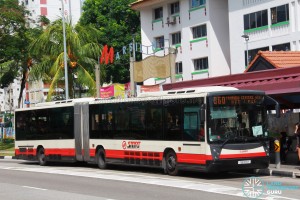
Despite the fire damage, enough of the chassis survived the accident. The bus was subsequently deregistered and underwent a two-year period of absence where it was rebuilt from scratch. On 23 August 2010, it was back on the roads, appearing on Service 962.
Much of the bus was rebuilt with new parts, bearing a resemblance to SMRT’s OC500LEs, and red/purple leather seats were used, identical to the ones found on early refurbished O405s. Two Konvekta air-conditioning pods were mounted on the roof, and a new set of LAWO BENEFIT EDS units (of an orange LED matrix design) made it the most unique Hispano Habit on the roads.
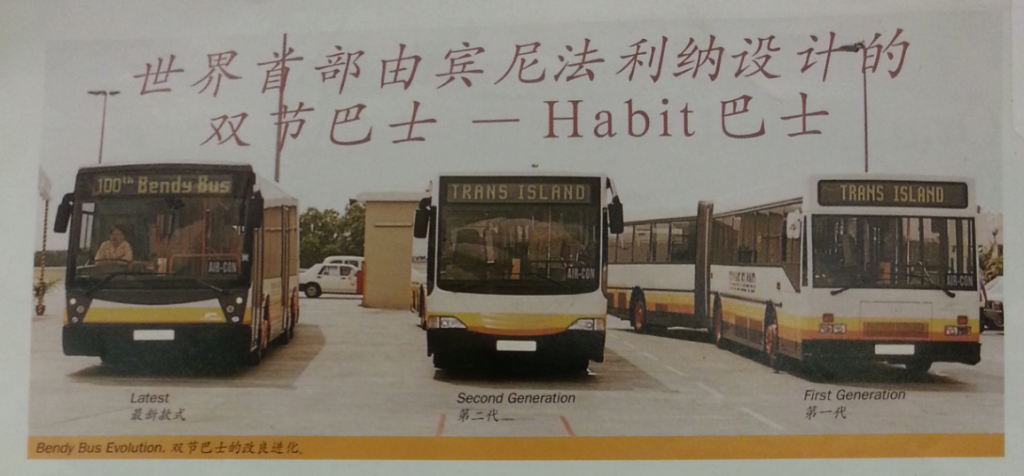
Interior:
The interior of the bus has two cabins permanently joined by an articulation unit. The bus seats four-abreast with a central aisle running the length of the bus. Grab poles and round hand grips are located on both sides of the aisle, with additional handrails at the standing area, or stanchion poles near the exits or articulation unit. All seats also have hand grips to provide commuters with additional support.
Bus stopping bell-pushes are located around the bus cabin, either mounted to stanchion poles or on the pillars in-between windows. Emergency hammers are also located on these pillars.
The front cabin has a front entrance door and middle exit door, with a small standing area opposite the exit door. Four rear-facing seats are located just behind the front axle wheel wells. The Passenger Information System (PIS), a LED text display, shows the next bus stop name, along with “Bus Stopping” if the stop button has been pressed.
One might notice that the seats used are different between the photos below. Indeed, different buses were refurbished with different models of seats. The ones with the shallow, rounded bar above the seat are Vogelsitze System 600 seats. The ones with the higher, angled bar forming a trapezoid shape are the Vogelsitze System 750/3 seats, which are found on many newer buses.
The rear cabin only has front-facing seats and a third exit door, and the last row of the bus has five seats.
The first-generation Passenger Information System (PIS), formerly located at the front of the bus, was relocated to the rear cabin and only shows the day, date and time.
Finally, the articulation unit consists of a turntable platform with two hinges in the middle, allowing for both pitch and yaw motion. Folding bellows help weatherproof the articulation unit. A single stanchion pole is also installed in the middle for additional support.
The driver’s compartment was also touted to be ergonomic and designed with improved visibility angles for the comfort and safety of the driver.
The turquoise unit on the bottom left is the New On-board Bus Equipment (NOBE) fare collection system. Just above that is the Trapeze Common Fleet Management System (CFMS). To the right is a small display monitor that functions as a reverse camera, which switches to a view of the third door when it is open.
Passenger Information Systems
There are different variants of Passenger Information Systems (PIS) used onboard Hispano Habit buses.
At the front cabin, the PIS displays the name of the next bus stop as static text. If the bus stop name exceeds the length of the display, the name will scroll on the display instead. It will also alternate between the bus stop name and “Bus Stopping” when the bus stop bell is pressed.
The older variant on the left is a LED display that only displays in red. On the right, the newer variant has a higher LED density and is able to display orange and green in addition to red.
At the rear cabin, some buses are mounted with an old PIS display formerly mounted at the front of the bus. It shows the time on the right, and scrolls between the day and the date on the left. In some buses, this PIS has been completely removed and replaced with an illuminated Bus Stopping indicator.
Gallery:
Gallery: (TIB1105H)
Main Article: TIB1105H: The rebuilt Habit
Check out the main article for more pictures and content.
Transmission Data:
- Voith DIWA 863.3 (TIB1025E – TIB1060C, TIB1062Y & TIB1208U – TIB1247G)
- ZF Ecomat 4HP 590 (The rest)
External Links & References:
Back to Mercedes-Benz O405G
Back to Bus Models
Back to Bus
Page 2 – Interior Gallery (Pre-Refurbishment)
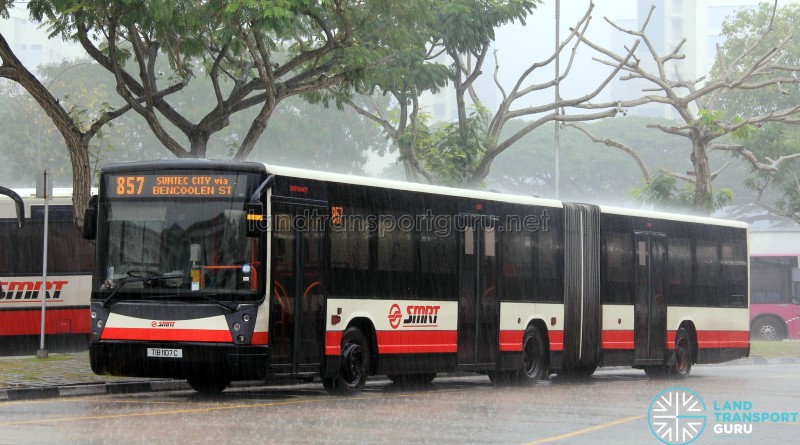

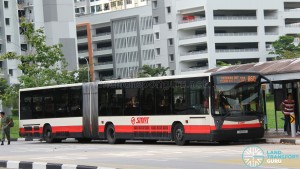

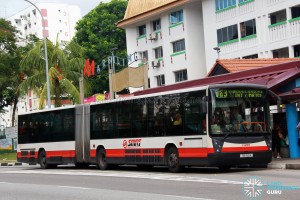
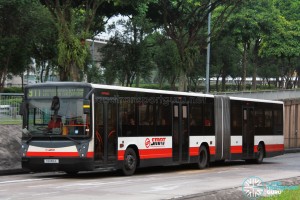
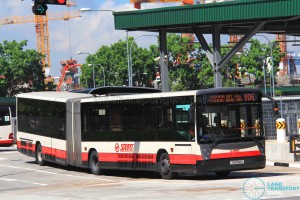

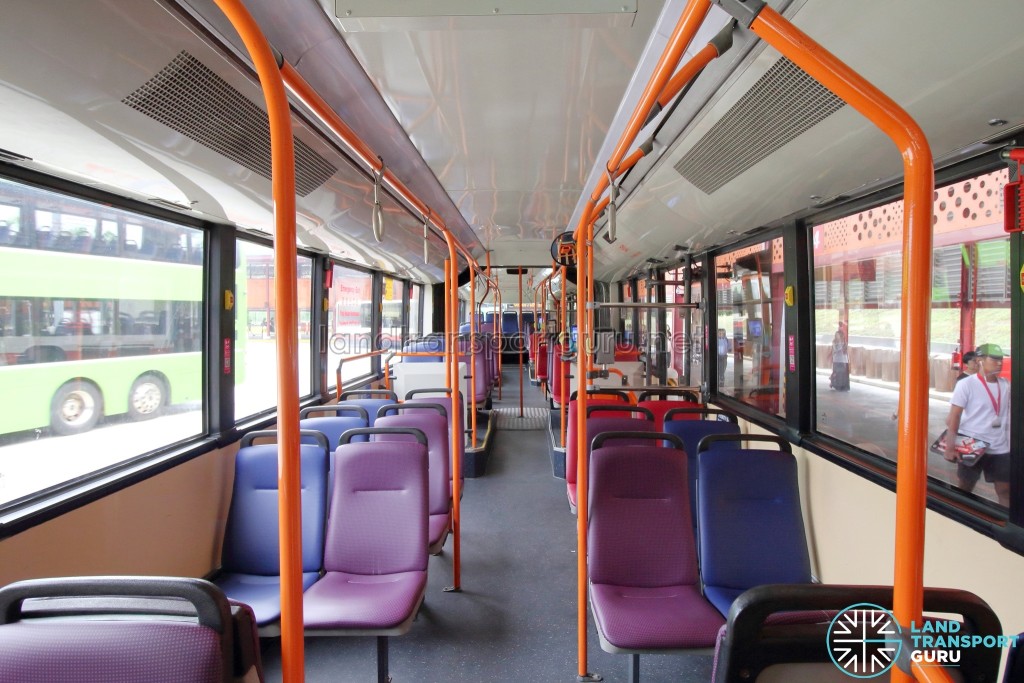

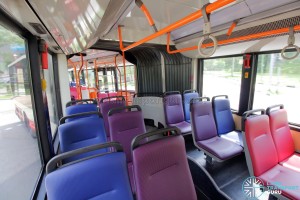
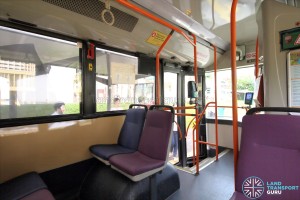
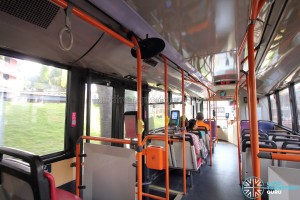
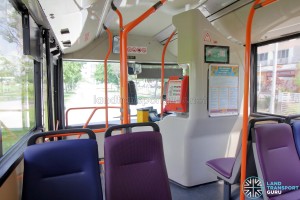
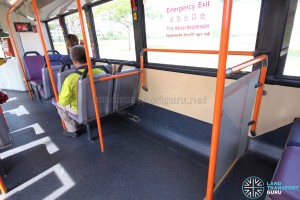

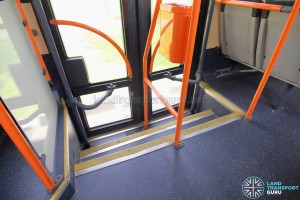
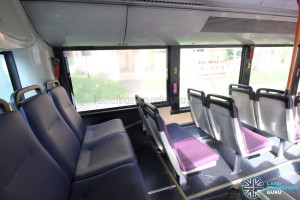
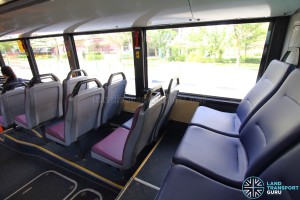
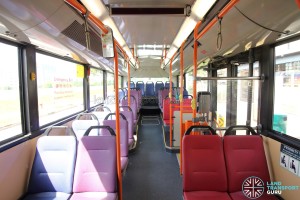
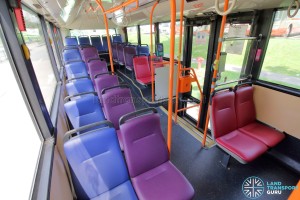
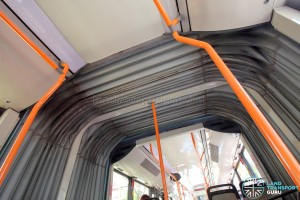
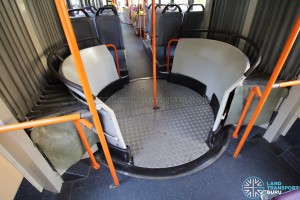

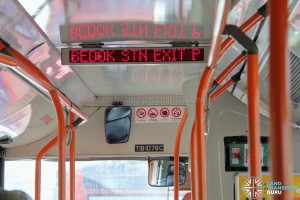
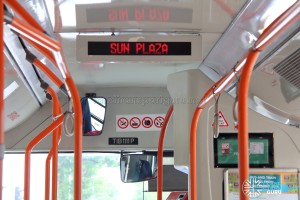
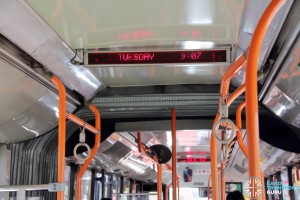
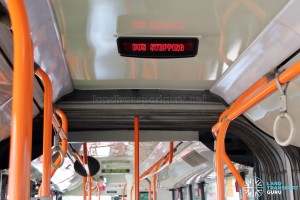


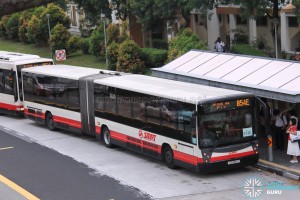
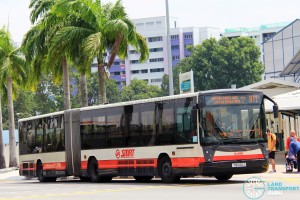
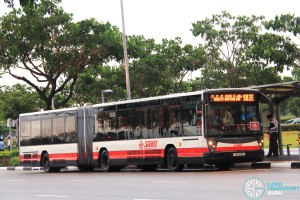

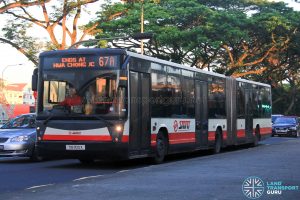
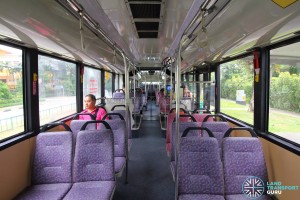
The last O405G was de-registered on 19 January 2021.
The last NWAB in revenue service was TIB1242U on 169, arriving at Woodlands Interchange at 1948h.
TIB1231B – TIB1247G will be retired by the end of this month instead of Jan 2020 (TIB1231B), Feb 2020 (TIB1232Z – TIB1234T), Mar 2020 (TIB1235R), Nov 2020 (TIB1236M – TIB1241Y), Jan 2021 (TIB1242U – TIB1244P) and Mar 2021 (TIB1245L – TIB1247G) as part of LTA’s 100% WAB fleet by early-2020.
how about TIB1221E